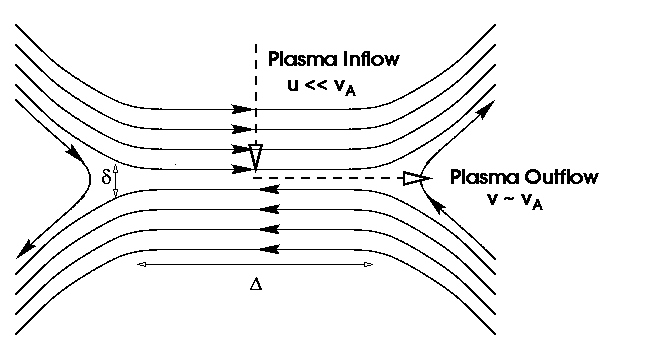

Magnetic reconnection (henceforth called "reconnection") refers to the breaking and reconnecting of oppositely directed magnetic field lines in a plasma. In the process, magnetic field energy is converted to plasma kinetic and thermal energy.
Reconnection is at the heart of many spectacular events in our solar system. For example, solar flares which occur near sunspots are believed to be powered by magnetic reconnection. Solar magnetic activity, including flares, can eject high energy charged particles into space. When the particles reach Earth, they can disrupt power grids and communications systems and threaten spacecraft and satellites. A related phenomenon is the aurora seen near the polar regions of Earth as well as on other magnetized planets. The Earth's own magnetic field is constantly perturbed by the impinging field from the sun (called the solar wind). During strong bursts (such as those caused by extraordinary solar flares) reconnection can be induced in the near-Earth magnetotail (a narrow magnetic field structure located on the night side many Earth-radii away). The tenuous plasma in that region is then accelerated down magnetic field lines into the polar regions, striking Earth's atmosphere and exciting nitrogen and oxygen atoms as well as other atoms present in our atmosphere. The immediate de-excitation of these atoms then emit the wonderful and often intricate display of light we know as the aurora or northern (and southern) lights.
In plasma physics, it is well known that magnetic field lines are "frozen-in" to an infinitely conductive plasma. Since charged plasma particles are confined to circular orbits around magnetic field lines, this means that infinitely conductive plasmas will not diffuse across field lines and mix. Conversely, two distinct field lines will remain separate since they cannot penetrate the intervening plasma. In most cases, solar and magnetospheric plasmas can be described very accurately with such a theory since they are both very conductive. However, straightforward application of the theory would remove the possibility of ejected solar plasma penetrating the magnetosphere since the plasmas would not be allowed to mix. Nevertheless, based on observations and known technological disruptions, we know that they must mix, but how?
The answer resides in the fact that when plasmas carrying oppositely directed magnetic field lines are brought together, a strong current sheet is established, in the presence of which even a vanishingly small amount of resistivity in a small volume can become important, allowing plasma diffusion and, thus, magnetic reconnection to occur.